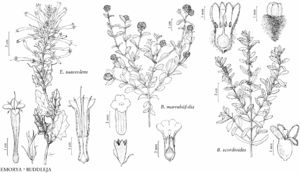Buddleja marrubiifolia
Prodr. 10: 441. 1846.
Shrubs, 5–20 dm. Stems much-branched, tomentose. Leaves: stipular lines faint; petiole 3–5 mm; blade grayish, ovate to rhombic, 1–6 × 1–2.5 cm, base cuneate, acute, or attenuate, margins crenate, apex obtuse or rounded, surfaces densely tomentose. Inflorescences terminal, capitate, 1–1.5 × 0.8–1.2 cm, cymes 1, 5–25-flowered. Pedicels essentially absent; bracteoles absent. Flowers fragrant; calyx tomentulose externally, tube 2–3.5 mm, lobes 1–1.5 mm; corolla deep yellow (turning orange), salverform, tube 3–4.5 mm, lobes orbiculate, 1–1.5 × 1.5–2 mm; stamens inserted in distal 1/3 of corolla-tube, included in tube; ovary ovoid, 1–1.5 mm, distal 1/2 glandular-tomentose; stigma clavate, slightly 2-lobed at apex, 0.6–1 mm. Fruits capsules, brown, oblong-ovoid, 3–4 × 1.5–2 mm, glandular-tomentulose at apex, dehiscence septicidal and loculicidal. Seeds ellipsoid, 1–1.3 × 0.2–0.3 mm, wings short at chalazal end. 2n = 38.
Phenology: Flowering Feb–Aug; fruiting Jul–Oct.
Habitat: Limestone cliffs and canyons.
Elevation: 600–1300 m.
Distribution
Tex., Mexico (Chihuahua), Mexico (Durango), Mexico (Hidalgo), Mexico (Nuevo León), Mexico (San Luis Potosí), Mexico (Tamaulipas), Mexico (Zacatecas)
Discussion
Buddleja marrubiifolia is found with Agave lechuguilla, Dasylirion leiophyllum, and Fouquieria splendens. In Mexico, it is found growing at elevations to 2300 m. Although cultivated in Arizona and Hawaii, it does not appear to have escaped in either state.
Selected References
None.
